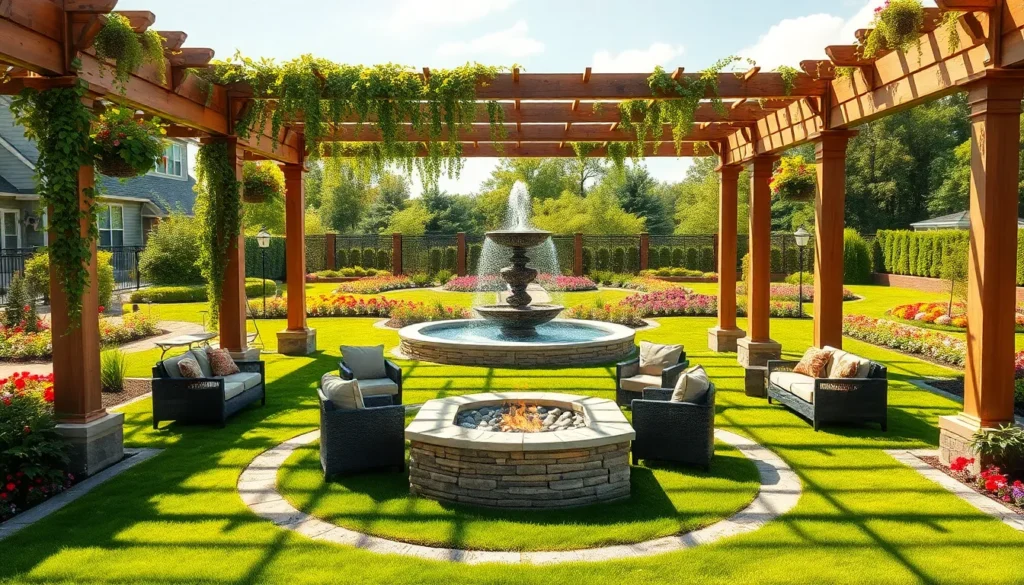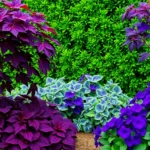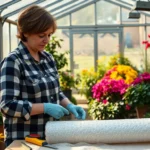Dreaming of transforming your expansive outdoor space into something spectacular? We know that having a big garden brings endless possibilities – and sometimes that can feel overwhelming. Whether you’ve just moved into a property with acres to spare or you’re finally ready to tackle that large backyard you’ve been ignoring, we’re here to help you unlock its full potential.
Big gardens offer unique opportunities that smaller spaces simply can’t match. You can create distinct zones for entertainment, relaxation, and cultivation while still maintaining open areas for kids and pets to roam freely. The key isn’t filling every square foot – it’s about creating purposeful spaces that flow together harmoniously.
We’ll share practical ideas that won’t expensive and can be implemented gradually over time. From dramatic focal points to sustainable landscaping answers, these strategies will help you create a garden that’s both beautiful and functional for years to come.
Create Stunning Focal Points With Large-Scale Garden Features
Large gardens demand impressive focal points that command attention and anchor your design. We’ll explore three powerful features that transform expansive spaces into captivating outdoor environments.
Install a Grand Water Feature or Fountain
Water features serve as magnificent centerpieces that bring movement and sound to sprawling garden spaces. We recommend installing a tiered fountain measuring 6-8 feet in diameter for gardens over 2,000 square feet, as it creates visual impact without overwhelming the space.
Natural pond systems work beautifully in large gardens, requiring approximately 150-200 square feet for optimal effect. Consider adding a waterfall element with rocks sourced locally to create a 3-4 foot cascade that generates soothing sounds throughout your outdoor area.
Modern water walls offer contemporary appeal and require minimal ground space while maximizing vertical impact. These features typically measure 8-12 feet in height and create dramatic reflections that enhance surrounding plantings like ornamental grasses and flowering perennials.
Build a Spacious Pergola or Gazebo
Pergolas create defined outdoor rooms within large garden spaces, typically requiring 12×16 feet minimum for comfortable seating and dining areas. We suggest using cedar or pressure-treated lumber for durability in various weather conditions, with posts spaced 8-10 feet apart for structural integrity.
Gazebos provide enclosed gathering spaces that work exceptionally well as garden focal points, especially when positioned 30-40 feet from your main house. Consider octagonal designs measuring 12-16 feet across, which accommodate 8-12 people comfortably for entertaining or relaxation.
Climbing plants enhance these structures significantly, with options like clematis, wisteria, and climbing roses providing seasonal interest and natural beauty. Plant 2-3 specimens around each structure’s base, spacing them 4-6 feet apart for proper coverage within 2-3 growing seasons.
Design a Fire Pit Area for Entertaining
Fire pit zones create natural gathering spaces that extend garden usability into cooler months, requiring approximately 20×20 feet for safe seating arrangements. We recommend stone or brick materials for permanent installations, with fire rings measuring 36-48 inches in diameter for groups of 8-12 people.
Seating arrangements should maintain 6-8 feet distance from fire pit edges, using natural stone benches, built-in walls, or weather-resistant furniture to create comfortable conversation areas. Consider incorporating gravel or flagstone surfaces beneath seating areas for easy maintenance and proper drainage.
Safety considerations include positioning fire pits at least 25 feet from structures and overhanging tree branches, while keeping fire extinguishers or water sources within 50 feet of the area. Install industry lighting along pathways leading to fire pit areas, using solar or low-voltage options spaced 8-10 feet apart for safe nighttime navigation.
Design Multiple Garden Rooms for Different Purposes
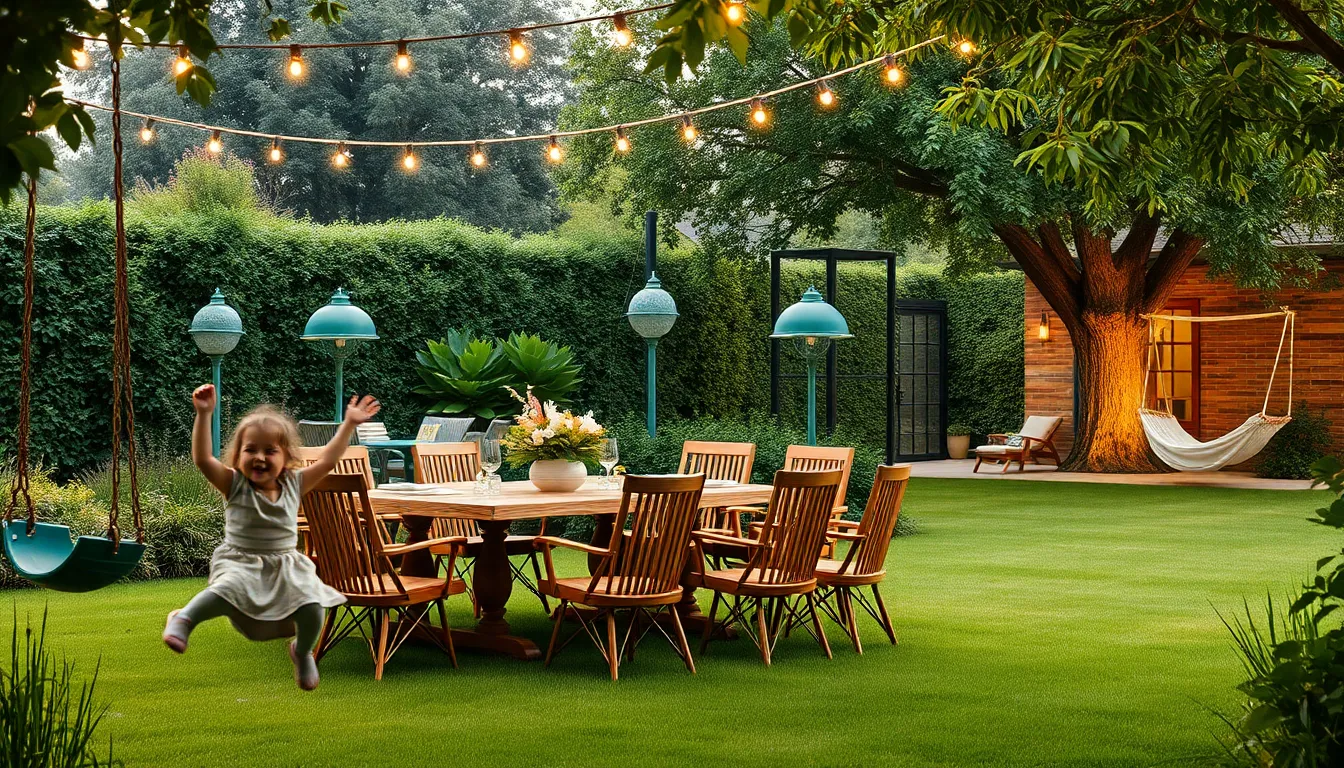
Creating distinct outdoor spaces transforms your large garden into a collection of purposeful areas that serve different activities and moods. We can divide our expansive space using pathways and fencing to establish intimate zones within the broader industry.
Establish a Formal Dining Area
Elegant outdoor dining sets become the foundation of our sophisticated entertaining space. We’ll position tables, chairs, and umbrellas in areas that naturally lend themselves to gathering and conversation.
String lights and lanterns enhance the ambiance during evening gatherings, creating a warm and inviting atmosphere. These lighting elements extend our dining hours and add magical touches to outdoor dinner parties.
Natural windbreaks like hedges or decorative screens provide protection from breezes while maintaining the formal aesthetic. We can incorporate weather resistant materials that withstand seasonal changes without losing their elegant appeal.
Create a Children’s Play Zone
Swings, slides, and sandbox installations transform one section of our garden into an captivating play environment. We’ll designate this active area away from delicate plantings and formal spaces to prevent conflicts between different garden uses.
Safety features require careful attention, particularly the surfaces beneath play equipment. Wood chips or rubber materials provide cushioning for falls while maintaining an attractive appearance that complements our overall garden design.
Shade structures over play areas protect children during sunny days and extend playtime comfort. We can use pergolas, shade sails, or strategically planted trees to create natural cooling zones within the active play space.
Develop a Quiet Reading Nook
Secluded locations under existing trees or purpose built gazebos offer natural shade and peaceful environments. We’ll choose spots that feel removed from high traffic areas while remaining accessible through garden pathways.
Comfortable outdoor seating with weather resistant cushions creates our personal retreat space. Benches, chairs, or even hammocks work well depending on our preferred reading position and the available space configuration.
Sound barriers from nearby activity zones help maintain the tranquil atmosphere essential for focused reading. We can use plantings, water features, or decorative panels to create acoustic separation between our quiet nook and more active garden areas.
Incorporate Expansive Lawn Areas for Recreation and Relaxation
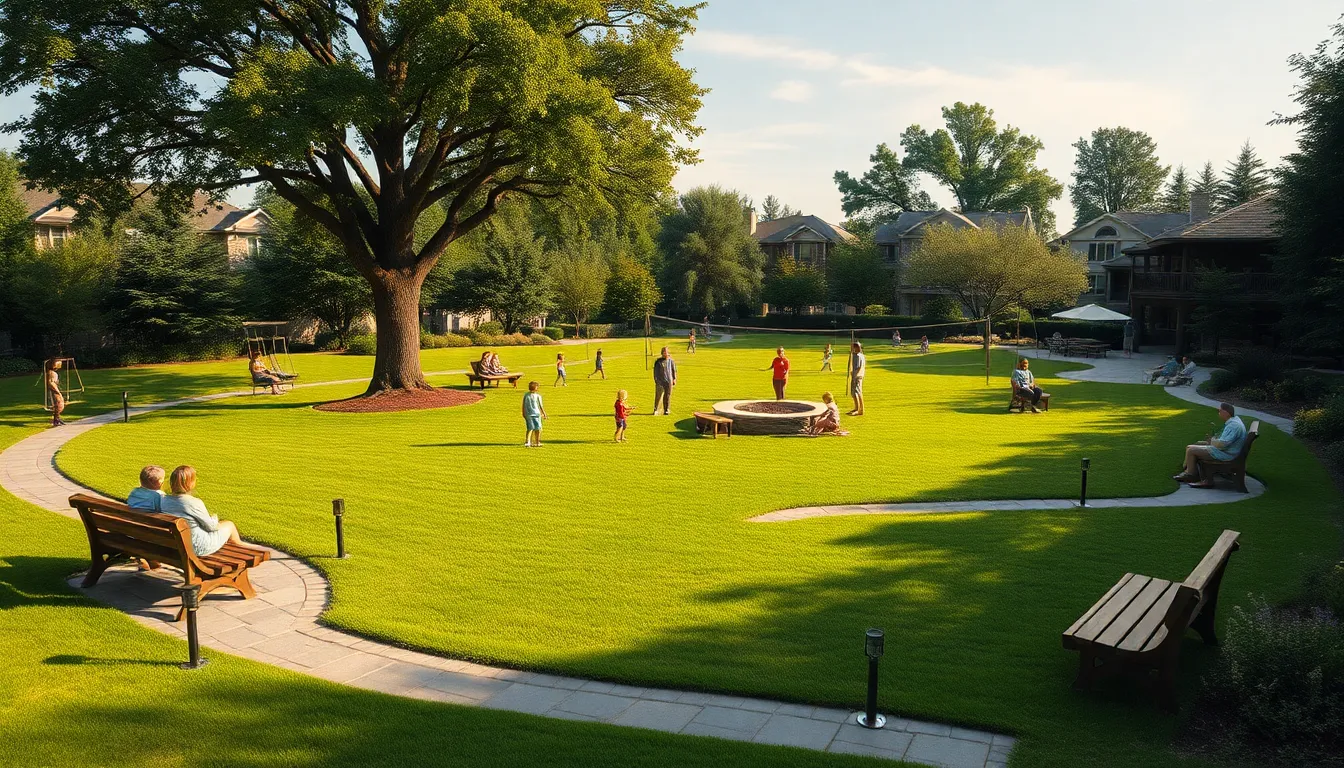
Large gardens offer incredible potential for creating sprawling lawn spaces that serve multiple purposes throughout the year. We’ll explore how to maximize these green expanses for both active recreation and peaceful relaxation.
Plan Open Spaces for Outdoor Games
Multi-use areas transform your big garden into an entertainment hub that accommodates various outdoor activities throughout the seasons. Consider installing permanent features like a badminton net post system or volleyball court markings that blend seamlessly with your industry design.
Sports enthusiasts will appreciate dedicated zones for soccer, croquet, or even a large outdoor chessboard painted directly onto a concrete pad within the lawn area. We recommend maintaining at least 30×50 feet of unobstructed grass space to accommodate most recreational activities comfortably.
Play zones designed specifically for children should feature soft, synthetic turf surfaces that provide safety without sacrificing durability. Install playground equipment like swings and slides at appropriate distances from game areas to prevent conflicts between different age groups using the space simultaneously.
Design Curved Pathways Through the Grass
Stone pavers create elegant curved walkways that guide visitors through your expansive lawn while adding visual interest to otherwise flat terrain. We suggest using natural materials like flagstone or brick that complement your garden’s overall aesthetic rather than competing with it.
Gravel paths offer a cost-effective alternative that’s particularly suitable for informal garden designs where you want to maintain a relaxed, countryside feel. Choose materials that provide good drainage and won’t shift excessively under foot traffic.
Wide pathways ensure accessibility for all family members and guests, with a minimum width of 4 feet recommended for comfortable two-way traffic. Install low-voltage LED lighting along pathway edges to enhance safety during evening use and create ambient lighting effects that extend your garden’s usability into darker hours.
Add Strategic Seating Areas
Shaded benches positioned near mature trees or pergolas provide comfortable retreat spots where family and friends can relax while enjoying views of your expansive lawn areas. We recommend placing seating at least 15 feet from active play zones to maintain peaceful relaxation spaces.
Circular seating arrangements around fire pits create natural gathering spaces that encourage social interaction and extend your garden’s entertainment season into cooler months. Choose weather-resistant materials like teak or powder-coated aluminum that maintain their appearance with minimal maintenance.
Patio furniture strategically placed near water features combines the soothing sounds of moving water with comfortable seating for reading, conversation, or quiet contemplation. Position these areas to take advantage of natural shade patterns throughout the day while maintaining easy access to your home’s indoor facilities.
Plant Large-Scale Trees and Shrubs for Structure and Privacy
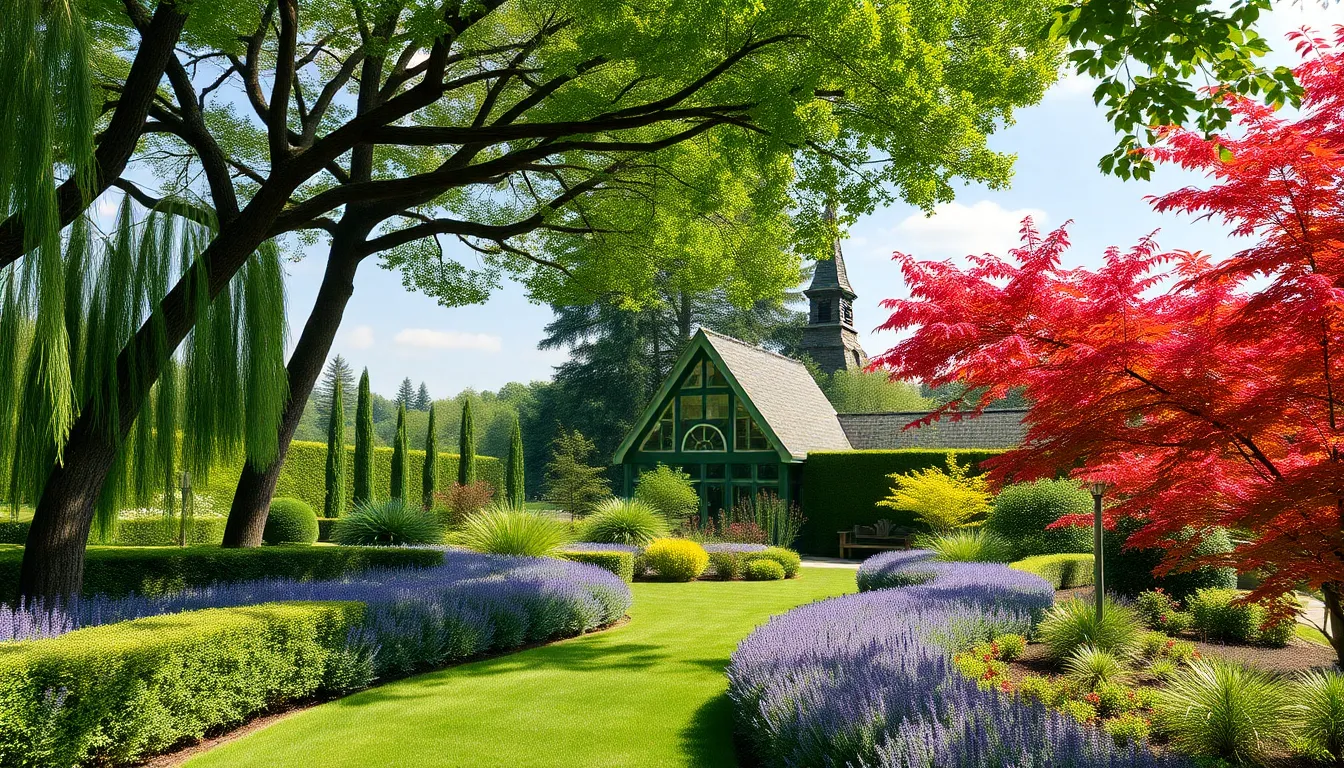
Establishing the foundational framework of your big garden begins with selecting the right large-scale trees and shrubs. These living structures serve as natural barriers while creating distinct zones throughout your expansive outdoor space.
Choose Fast-Growing Shade Trees
Fast-growing shade trees transform your big garden ideas into reality within just a few growing seasons. Willows and poplars stand out as excellent choices that quickly reach impressive heights while providing substantial canopy coverage. These varieties reduce sunlight intensity effectively, protecting delicate plants beneath while creating comfortable outdoor spaces for relaxation and entertainment.
Positioning becomes crucial when incorporating fast-growing species into your garden design. We recommend planting these trees at least 20 feet from your home’s foundation to accommodate their mature root systems. Strategic placement near seating areas or play zones maximizes their cooling benefits during hot summer months.
Selection criteria should include your local climate zone and soil conditions. Hybrid poplars can grow up to 8 feet per year in optimal conditions, while weeping willows thrive in moist soil areas and create dramatic focal points with their graceful drooping branches.
Create Natural Borders With Hedgerows
Hedgerows establish clear boundaries within your large garden space while maintaining an organic, flowing aesthetic. Lavender and rosemary hedgerows offer dual benefits as natural borders that provide privacy definition plus aromatic appeal throughout your outdoor areas. These Mediterranean plants create stunning visual separation between different garden rooms without requiring expensive hardscaping materials.
Maintenance requirements for hedgerows include regular pruning to maintain their shape and promote healthy growth. We suggest trimming established hedgerows twice annually during spring and late summer to prevent overgrowth and maintain crisp lines. Proper spacing between individual plants ensures adequate air circulation and prevents disease issues.
Height considerations vary depending on your privacy needs and garden layout. Low hedgerows measuring 2-3 feet work well for defining pathways and flower bed borders, while taller varieties reaching 5-6 feet provide substantial screening between activity zones.
Add Ornamental Trees as Statement Pieces
Ornamental trees serve as living sculptures that anchor your big garden design with stunning visual interest. Cherry blossoms create breathtaking spring displays with their delicate pink or white flowers, while Japanese maples provide year-round appeal through their unique leaf shapes and vibrant fall colors. These specimen trees work best when placed strategically to create focal points that draw the eye through your garden industry.
Placement strategy involves considering sight lines from multiple vantage points throughout your property. We recommend positioning ornamental trees where they can be appreciated from indoor living spaces as well as outdoor seating areas. Single specimens work beautifully as standalone features, while groupings of three create more dramatic impact in larger spaces.
Seasonal interest becomes a key factor when selecting ornamental varieties for your big garden ideas. Flowering dogwoods provide spring blooms followed by attractive fall foliage, while Japanese maples offer stunning autumn colors that complement your existing industry palette. Consider bloom times and foliage changes to ensure continuous visual appeal throughout the growing season.
Establish Extensive Flower Beds and Perennial Gardens
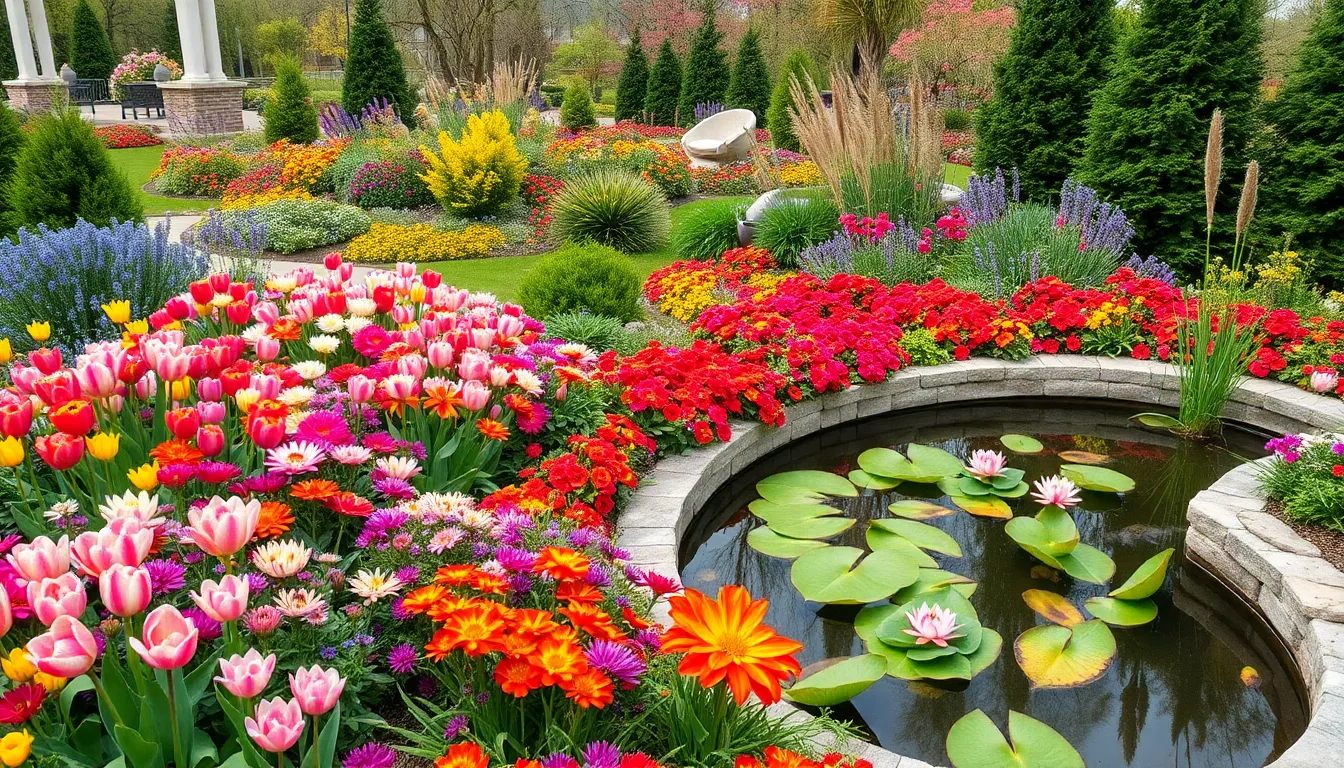
Creating stunning flower displays becomes the cornerstone of transforming your big garden into a year-round showcase. We’ll explore how to design ever-changing plantings that provide continuous visual interest throughout every season.
Design Seasonal Color Displays
Spring transforms your garden with vibrant bulb displays like tulips and daffodils that emerge after winter’s dormancy. These early bloomers create dramatic sweeps of color when planted in large drifts of 50-100 bulbs per variety. Layering different bloom times ensures continuous flowers from February through May.
Summer brings warm-season annuals like zinnias and sunflowers that thrive in your garden’s sunny expanses. Zinnias offer 8-12 weeks of continuous blooms when deadheaded regularly, while sunflowers create dramatic vertical elements reaching 6-10 feet tall. Grouping these plants in masses of 15-25 creates maximum visual impact.
Fall extends your garden’s beauty with plants featuring vibrant autumn colors like maple trees and asters. Japanese maples provide brilliant red and orange foliage, while New England asters bloom in purple clusters from September through October. These plants ensure your garden remains captivating as temperatures cool.
Winter maintains visual interest through evergreen shrubs and ornamental grasses that provide structure when other plants go dormant. Feather reed grass and blue spruce create textural contrast against snow, while winterberry holly adds bright red berries that persist through February.
Create Themed Garden Sections
Water gardens incorporate ponds, fountains, or small waterfalls that add soothing sounds and attract beneficial wildlife to your space. Installing a 6-8 foot diameter pond creates enough surface area for water lilies and provides habitat for frogs and birds. Recirculating fountains offer the same acoustic benefits while requiring less maintenance than natural ponds.
Cutting gardens dedicate exact areas for growing flowers intended for indoor arrangements and special occasions. Planting rows of cosmos, dahlias, and gladioli in 4-foot wide beds allows easy access for harvesting. These dedicated spaces produce 20-30 stems per week during peak season without depleting your display gardens.
Herb gardens establish sections focused on culinary plants that enhance your cooking while providing aromatic interest. Grouping Mediterranean herbs like rosemary, thyme, and oregano in well-draining raised beds creates both functional and beautiful displays. These plants often double as ornamentals with their attractive foliage and small flowers.
Plan for Year-Round Interest
Structural elements incorporate trees, shrubs, and garden ornaments that provide backbone and visual weight during every season. Evergreen trees like blue spruce and Norway spruce maintain their presence year-round, while deciduous trees add seasonal changes. Garden sculptures and architectural features create focal points that remain attractive even in winter.
Seasonal plant rotation maintains visual excitement by swapping out annuals three times per year for continuous color changes. Spring pansies give way to summer petunias, which transition to fall mums and ornamental cabbage. This strategy keeps your beds looking fresh while maximizing bloom time in each location.
Strategic lighting highlights key garden features during evening hours and extends your outdoor enjoyment into darker months. Solar spotlights positioned at the base of specimen trees create dramatic uplighting effects, while string lights draped through pergolas add magical ambiance. LED pathway lights ensure safe navigation while maintaining your garden’s nighttime beauty.
Build Functional Structures and Storage Solutions
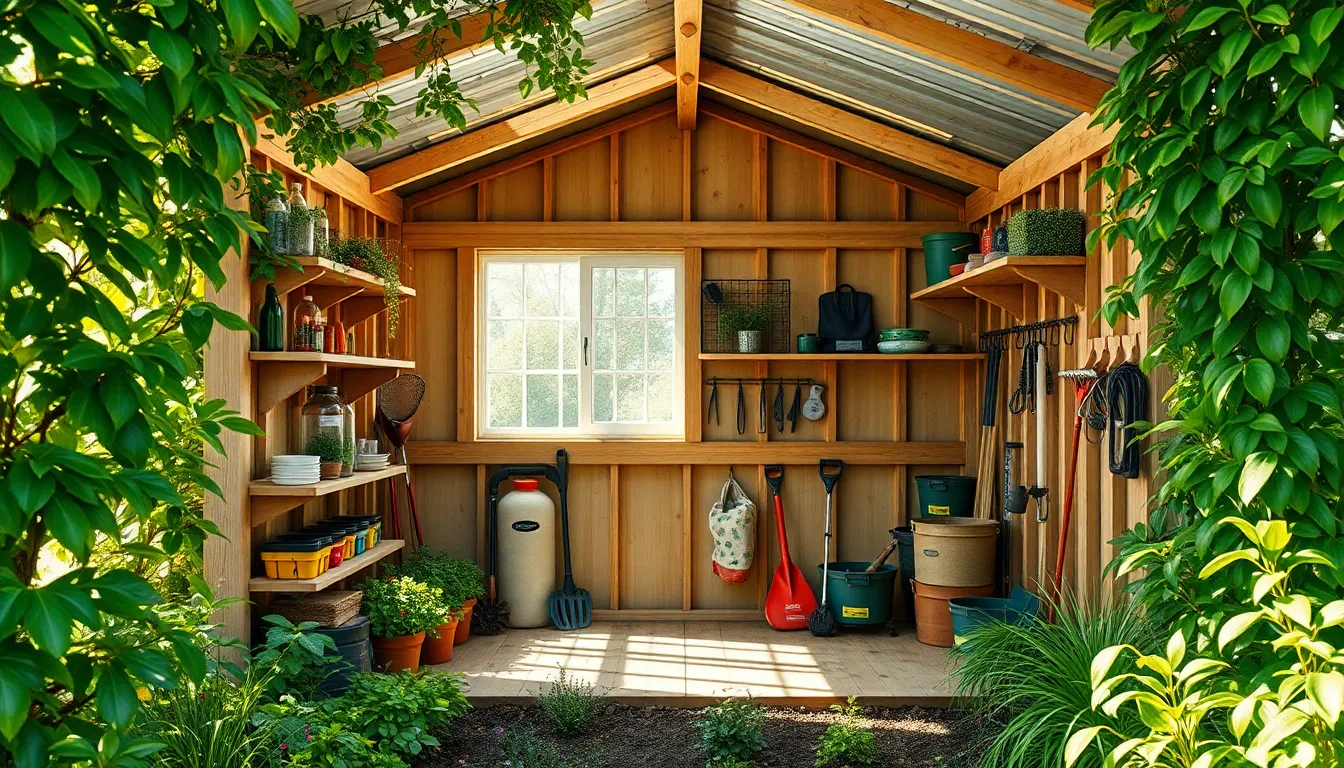
Large gardens benefit tremendously from well-planned structures that combine practicality with visual appeal. Smart storage answers and functional buildings transform sprawling outdoor spaces into organized, efficient areas that support all your gardening activities.
Construct a Spacious Garden Shed
Garden sheds serve as central command centers for all your outdoor equipment and supplies. We recommend choosing between prefabricated options for quick installation or custom-built designs that perfectly match your garden’s style and exact storage needs.
Essential features include multiple shelving systems, wall-mounted hooks for tools, and windows that provide natural light during daytime work sessions. Weather protection becomes crucial for valuable equipment like mowers, trimmers, and seasonal decorations that need secure storage year-round.
Organizational benefits multiply when you install dedicated sections for different tool categories, creating easy access and reducing time spent searching for equipment. Consider adding electrical outlets for battery charging stations and overhead lighting for evening projects.
Install Raised Vegetable Beds
Raised beds maximize growing efficiency in large garden spaces through improved drainage and easier maintenance access. We suggest arranging four or more beds in symmetrical patterns to create classic garden layouts that look professionally designed.
Waist-high construction eliminates back strain during planting, weeding, and harvesting activities. Twin garden rows work exceptionally well for crop rotation systems, allowing you to alternate plant families between seasons for soil health.
Soil customization becomes possible with raised beds, letting you create perfect growing conditions for exact vegetables without amending your entire garden. Root development improves significantly in loose, well-draining raised bed soil compared to compacted ground-level planting areas.
Enhanced weed control occurs naturally since you’re working with contained growing spaces rather than battling weeds across vast open areas. Accessibility increases for gardeners of all ages and physical abilities when beds are built at comfortable working heights.
Add Outdoor Kitchen or Cooking Area
Outdoor kitchens extend your living space into the garden while creating natural entertainment hubs for family gatherings. Built-in grills, prep surfaces, and storage cabinets transform harvest-to-table cooking into seamless outdoor experiences.
Pizza ovens add authentic cooking capabilities that make garden parties memorable and encourage more frequent outdoor dining. We recommend including adequate counter space for food preparation and serving areas that accommodate multiple guests comfortably.
Storage integration keeps cooking utensils, plates, and supplies organized within easy reach of all cooking surfaces. Harvesting garden produce becomes incredibly convenient when your cooking area sits directly adjacent to vegetable beds and herb gardens.
Weather-resistant materials like stainless steel and natural stone ensure your outdoor kitchen withstands seasonal changes while maintaining its functionality. Proper ventilation and lighting systems make evening cooking sessions safe and enjoyable throughout the year.
Create Walking Paths and Circulation Routes
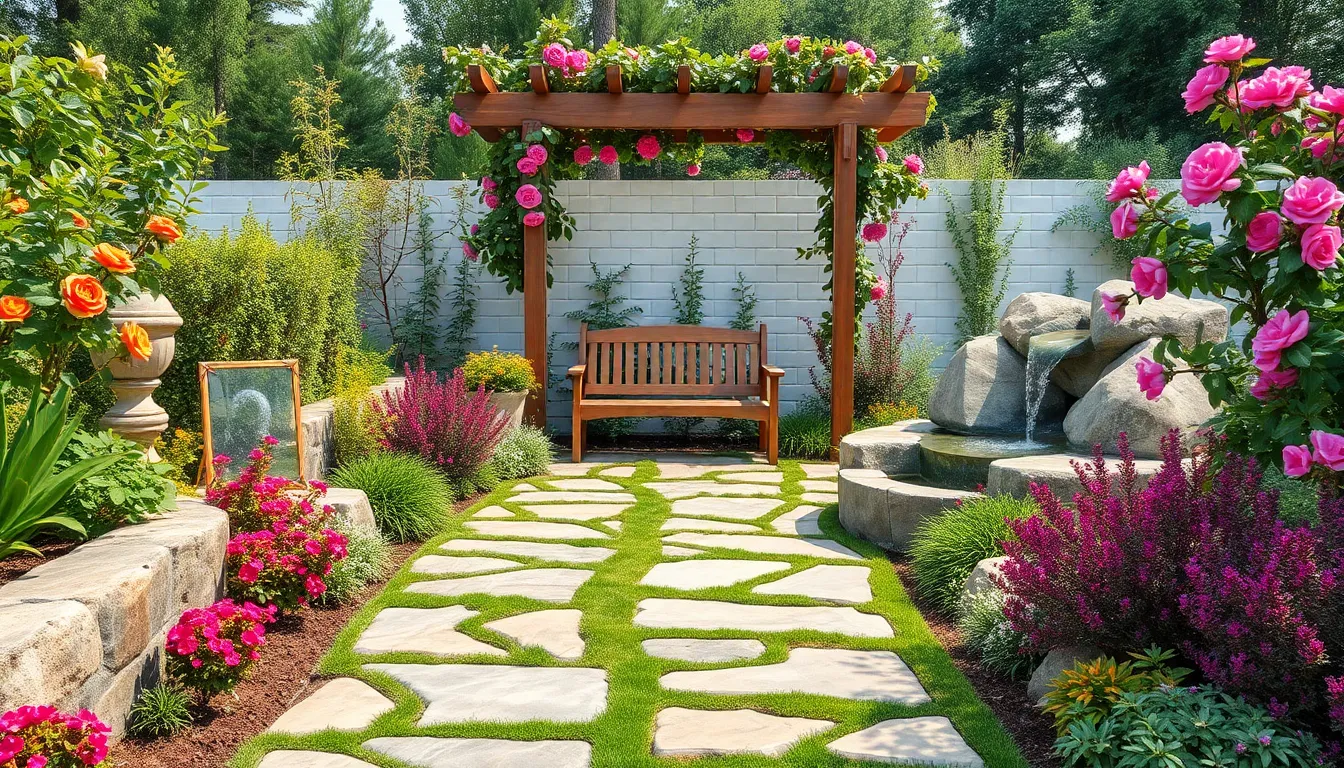
Well-designed pathways serve as the backbone of large garden navigation, guiding visitors through different areas while creating visual interest and functional flow.
Design Grand Entrance Walkways
Statues and fountains transform ordinary entrances into memorable first impressions that set the tone for your entire garden experience. Position these focal points strategically along the walkway to create natural stopping points and photo opportunities.
Tree and shrub placement along entrance paths provides essential shade while adding vertical dimension and seasonal interest. Plant larger specimens like oak trees or ornamental maples at 15-20 foot intervals to create a grand canopy effect.
Solar-powered lighting illuminates pathways during evening hours, extending garden enjoyment and ensuring safe navigation. Install lights every 6-8 feet along the walkway to maintain consistent visibility without overwhelming the natural ambiance.
Connect Different Garden Areas
Modern arches and trellises create seamless transitions between garden rooms while providing vertical growing space for climbing roses, clematis, or grape vines. Position these structures at natural transition points to frame views of the next garden area.
Water features like streams or ponds serve as natural connectors that draw visitors from one space to another through sight and sound. Create meandering water channels that flow between different garden sections to establish visual continuity.
Strategic seating areas encourage exploration by providing rest stops throughout the garden journey. Place benches or garden chairs at key viewpoints where visitors can pause and appreciate different garden perspectives.
Incorporate Stepping Stone Paths
Nature-inspired stone designs add whimsical elements that make garden walks more captivating and interactive. Choose stones with interesting textures, colors, or carved messages that reflect your garden’s personality.
Companion plantings around stepping stones soften hard edges while creating intimate micro-gardens along the pathway. Plant low-growing herbs like thyme or creeping phlox between stones for fragrance and color.
Built-in planter stones maximize growing space by incorporating small planting pockets directly into pathway elements. Fill these integrated planters with succulents or small perennials that can withstand foot traffic and weather exposure.
Develop Specialty Gardens and Unique Features
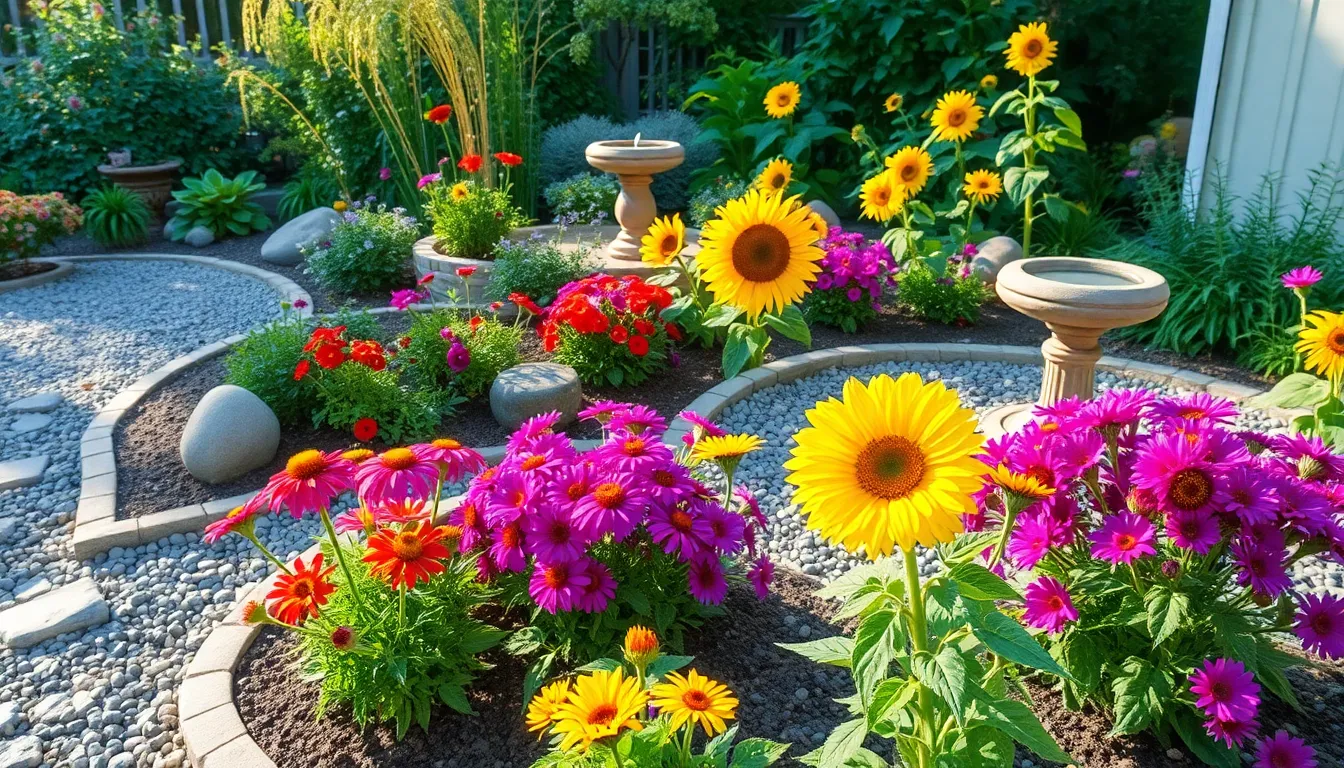
We can transform sections of our large garden into specialized areas that serve exact purposes while adding depth and character to the overall industry.
Establish a Cutting Garden
Establish a Cutting Garden to ensure we always have fresh flowers for indoor arrangements throughout the growing season. We should design this area with rows of annuals and perennials that provide continuous blooms from spring through fall.
Plant a variety of flower types including zinnias, cosmos, and sunflowers for summer color, along with hardy perennials like peonies and delphiniums for reliable yearly displays. We can organize plants by height with taller specimens in the back and shorter ones in front for easy harvesting.
Select flowers with different bloom times to maintain consistent cutting material from early spring bulbs through late season dahlias and chrysanthemums. We should include foliage plants like eucalyptus and dusty miller to add texture and greenery to our arrangements.
Dedicate separate beds for different seasons with one area focused on spring bulbs and cool weather annuals, another for summer heat lovers, and a third for fall blooming varieties. We can maximize our harvest by succession planting quick growing annuals every few weeks.
Create a Meditation or Zen Garden
Create a meditation garden that emphasizes tranquility through carefully selected elements like gravel pathways, strategically placed stones, and minimal plantings. We should focus on creating a peaceful atmosphere that encourages quiet reflection and stress relief.
Incorporate gravel and stone features as the foundation of our zen space, using raked gravel patterns around larger accent stones to create visual focal points. We can add a simple water feature like a small fountain or shallow reflecting pool to introduce gentle sounds.
Choose plants that enhance serenity including ornamental grasses, bamboo, and evergreen shrubs that maintain their structure year round. We should select species with subtle colors and soft textures rather than bold, attention grabbing varieties.
Design pathways that encourage slow movement using stepping stones or curved gravel paths that naturally guide visitors through the space at a contemplative pace. We can add a simple bench or meditation platform positioned to take advantage of morning sunlight or evening shadows.
Design a Wildlife Habitat Area
Design a wildlife habitat using native plants, natural water sources, and varied shelter options to attract and support local birds, bees, butterflies, and other beneficial creatures. We should create diverse microhabitats that provide food, water, shelter, and nesting sites throughout the seasons.
Plant native species that support local ecosystems including flowering trees like dogwood or serviceberry, native shrubs such as elderberry or spicebush, and wildflowers that provide nectar and seeds. We can group plants in natural clusters rather than formal arrangements to mimic natural habitats.
Provide multiple water sources ranging from shallow bird baths and puddling areas for butterflies to deeper features for larger wildlife, ensuring fresh water availability year round. We should position water features near cover plants where animals feel safe while drinking.
Create shelter and nesting opportunities by leaving areas of native grasses uncut through winter, installing bird houses appropriate for local species, and maintaining brush piles or stone walls where small creatures can find protection. We can designate quiet zones where wildlife can feed and rest undisturbed by foot traffic.
Plan for Outdoor Entertainment and Gathering Spaces
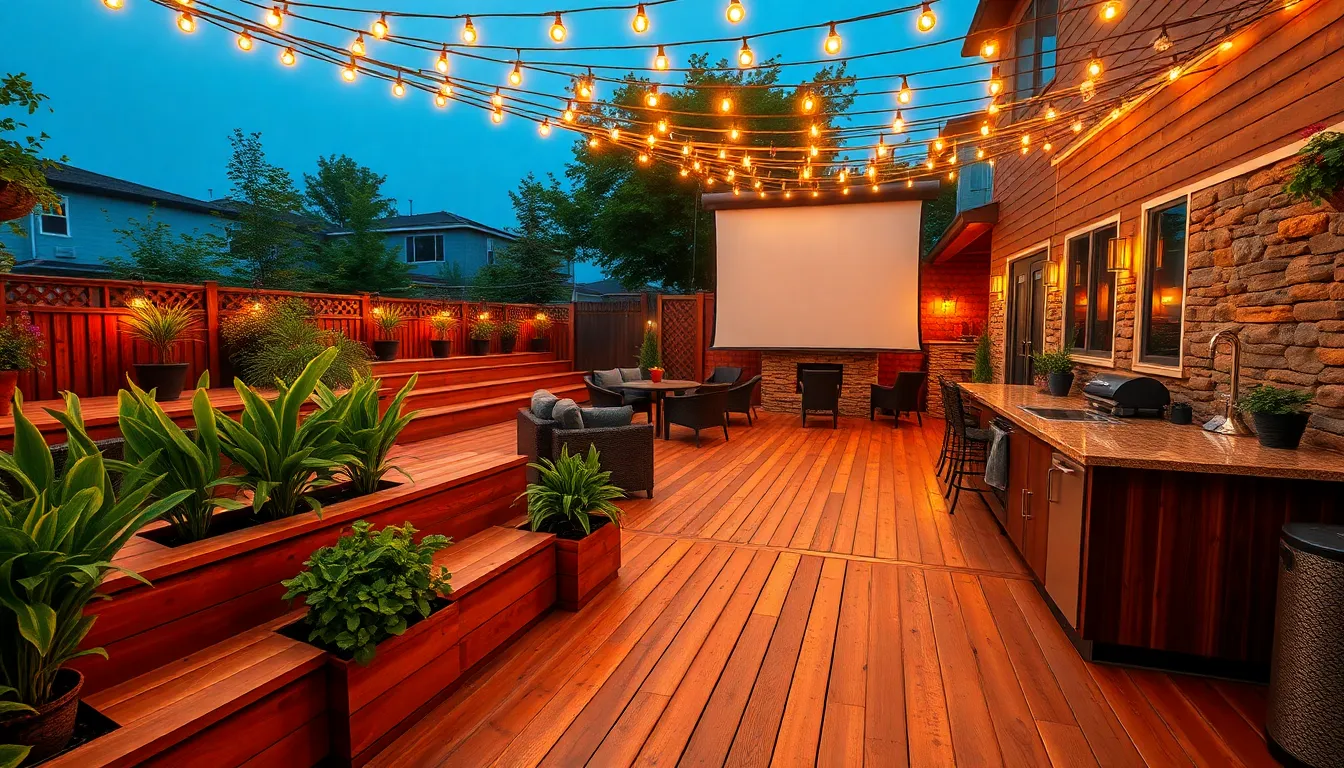
We’re ready to transform our expansive garden into the ultimate entertainment destination that’ll become the heart of our outdoor living experience.
Build a Large Deck or Patio
Large patios serve as the foundation for memorable outdoor gatherings. We recommend designing spacious seating areas that can accommodate multiple conversation groups while maintaining an open flow throughout the space. Built-in planters along the perimeter create natural borders and add greenery without sacrificing precious floor space.
Integrated outdoor kitchens elevate our entertaining capabilities significantly. Consider incorporating a full cooking station with countertop space, storage, and seating areas that encourage guests to gather around the chef. Decorative elements like stone accents or pergola overhead structures provide visual interest and define the cooking zone.
Built-in seating maximizes our patio’s functionality while reducing furniture needs. We can design custom benches with storage compartments underneath or create tiered seating levels that follow the natural contours of our industry. Planters integrated into railing systems add vertical growing space for herbs or flowers.
Install Outdoor Lighting Systems
String lights create magical ambiance that transforms our garden into an enchanting evening retreat. We suggest hanging them at varying heights throughout our entertainment area, creating layers of warm light that make guests feel welcome and comfortable. Edison bulb styles provide vintage charm while LED options offer energy efficiency.
Solar powered lights eliminate electrical installation costs while highlighting our garden’s best features. Strategic placement along pathways, around seating areas, and near water features ensures safety while showcasing our industry design. Motion sensor options provide security benefits without disrupting the peaceful atmosphere.
Uplighting techniques dramatize our large trees and architectural elements after dark. We can install ground level fixtures that cast shadows and create depth throughout our entertainment spaces. Color changing LED systems allow us to customize the mood for different events and seasons.
Create Amphitheater Style Seating
Tiered seating areas provide an immersive experience for outdoor movie nights and performances. We recommend using natural slope variations in our large garden to create graduated levels that offer excellent sightlines for every guest. Stone or timber retaining walls can form the structure while providing comfortable backrest support.
Natural seating materials blend seamlessly with our garden surroundings while offering durability. Large boulders arranged in curved formations create informal gathering spots that feel organic and inviting. Wood benches built into terraced areas provide more formal seating options for structured events.
Central focal points anchor our amphitheater design and draw attention toward the entertainment area. We can install an inflatable screen setup for movie nights or create a natural stage area using our existing industry features. A snack bar positioned at the back of the seating area ensures easy access without disrupting the viewing experience.
Conclusion
We’ve explored countless possibilities for transforming your expansive outdoor space into a garden that truly reflects your lifestyle and dreams. From grand water features to cozy meditation corners each element contributes to creating an outdoor sanctuary that serves multiple purposes throughout the seasons.
Remember that the beauty of a large garden lies in its ability to evolve over time. You don’t need to carry out every idea at once – start with the features that excite you most and gradually build upon your foundation. The key is creating a cohesive design that flows naturally from one area to the next.
Your big garden has the potential to become the heart of your home where memories are made and nature thrives. With thoughtful planning and strategic implementation you’ll soon have an outdoor space that’s both stunning and supremely functional.
Frequently Asked Questions
What are the most effective focal points for large gardens?
The three most powerful focal points for large gardens are grand water features or fountains, spacious pergolas or gazebos, and fire pit areas. Water features add movement and soothing sounds, pergolas create defined outdoor rooms and support climbing plants, while fire pits extend garden usability into cooler months and provide natural gathering spaces for entertainment.
How do I create different garden rooms in a large outdoor space?
Design multiple purposeful areas such as a formal dining space, children’s play zone, and quiet reading nook. Use natural barriers like hedges, pergolas, or strategically placed trees to define each area. Connect these rooms with curved pathways made from natural materials to create flow and accessibility throughout your garden.
What’s the best approach for designing pathways in large gardens?
Create curved pathways using natural materials like stone or gravel for visual interest and accessibility. Design grand entrance walkways with decorative elements, incorporate whimsical stepping stone paths for character, and use modern arches or trellises for seamless transitions between different garden areas while maintaining good circulation throughout the space.
How can I incorporate functional structures without compromising aesthetics?
Add garden sheds for storage, raised vegetable beds for cultivation, and outdoor kitchens for entertainment while ensuring they complement your garden’s design. Use materials that match your overall theme, position structures strategically to blend with existing features, and consider multi-functional elements that serve both practical and decorative purposes.
What specialty gardens work best in large outdoor spaces?
Consider creating a cutting garden for fresh flowers, a meditation or zen garden for tranquility, and a wildlife habitat area using native plants. Each specialty garden should be designed with specific plants and features that enhance its purpose, such as calming elements for meditation spaces and diverse native species for wildlife areas.
How do I plan outdoor entertainment areas effectively?
Build large decks or patios with spacious seating areas and integrated outdoor kitchens. Install comprehensive outdoor lighting systems including string lights and solar-powered options for ambiance and safety. Consider amphitheater-style seating for movie nights and performances, utilizing natural slopes and durable materials to enhance the entertainment experience.
What’s the best strategy for implementing large garden designs on a budget?
Implement your garden design gradually, focusing on one area at a time. Start with essential pathways and focal points, then add specialty gardens and entertainment areas over time. Use cost-effective materials like gravel for paths, choose perennial plants for long-term value, and consider DIY options for simpler structures while investing professionally in complex features.

